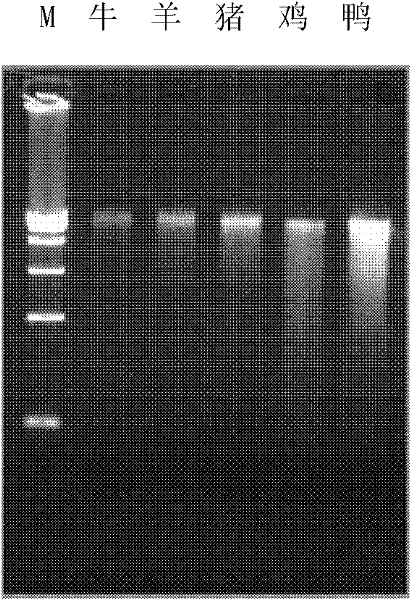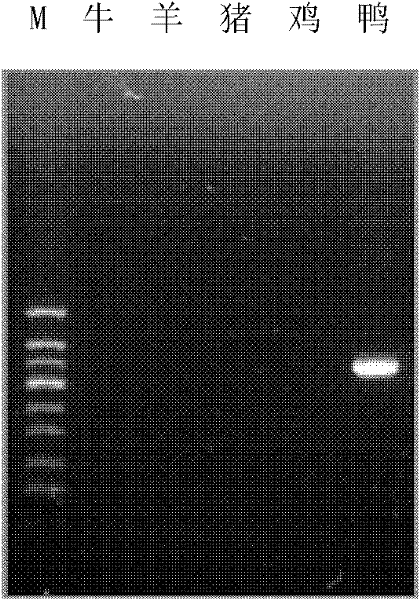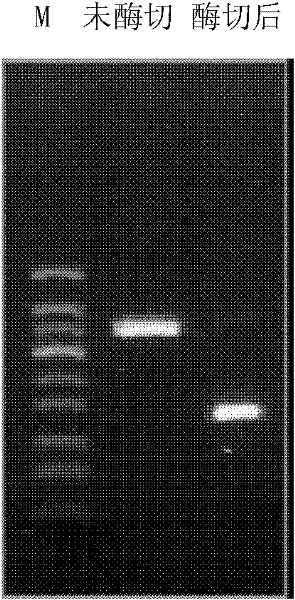Polymerase chain reaction (PCR) primer pair for identifying or assisting in identifying duck tissues and/or organs and application of PCR primer pair
A primer pair and duck identification technology, which is applied in the determination/inspection of microorganisms, DNA/RNA fragments, recombinant DNA technology, etc., can solve the problems of poor observation intuitiveness, complex technology, antibody specificity, etc., and achieve clear results, High reliability and specific effect
- Summary
- Abstract
- Description
- Claims
- Application Information
AI Technical Summary
Problems solved by technology
Method used
Image
Examples
Embodiment 1
[0044] Embodiment 1, utilize the PCR primer pair of identification or auxiliary identification duck tissue and / or organ to detect animal muscle sample
[0045]1. Preparation of PCR primer pairs for identification or auxiliary identification of duck tissues and / or organs
[0046] Taking duck mitochondrial DNA cytochrome oxidase subunit III gene as the target gene, a primer pair was designed to specifically amplify the gene. The sequence of the upstream primer is 5'-ATGTGATTCCACTACAACTCATCTAT-3' (sequence 1 in the sequence listing), and the sequence of the downstream primer is 5'-TGGTGGGCTCATGTGACAGTT-3' (sequence 2 in the sequence listing). The primer pair is the PCR primer pair for identifying or assisting in identifying duck tissues and / or organs. The primer pair amplifies the target sequence of Peking duck as shown in sequence 3 in the sequence listing. The 173-178th position of sequence 3 in the sequence listing is the recognition sequence of Hind III, and the PCR product...
Embodiment 2
[0078] Embodiment 2, utilize the PCR primer pair of identification or auxiliary identification duck tissue and / or organ to detect duck down feather sample
[0079] 1. Preparation of PCR primer pairs for identification or auxiliary identification of duck tissues and / or organs
[0080] The design and preparation method are the same as in Example 1.
[0081] 2. Detection of duck down samples
[0082] 1. Test samples
[0083] The test sample is Peking duck down.
[0084] 2. Using the primer pair in step 1 to PCR amplify the cytochrome oxidase subunit III gene fragment on the mitochondrial genome
[0085] 1) Extraction of sample genome
[0086] The hair DNA extraction kit-column type (AndyBio Company, product number M090050) was used to extract the total DNA in duck down feathers.
[0087] 2) PCR reaction
[0088] Using the DNA in the above step 1 as a template, the upstream primer shown in sequence 1 in the sequence listing and the downstream primer shown in sequence 2 in th...
Embodiment 3
[0097] Embodiment 3, utilize the PCR primer pair of identification or auxiliary identification duck tissue and / or organ to detect different duck meat samples
[0098]1. Preparation of PCR primer pairs for identification or auxiliary identification of duck tissues and / or organs
[0099] The design and preparation method are the same as step 1 of Example 1.
[0100] 2. Detection of various duck meat samples
[0101] 1. Test samples
[0102] The test samples were muscle of Shaoxing duck, mallard duck and Jianchang duck.
[0103] 2. Using the primer pair in step 1 to PCR amplify the cytochrome oxidase subunit III gene fragment on the mitochondrial genome
[0104] 1) Extraction of sample genome
[0105] With embodiment 1.
[0106] 2) PCR reaction
[0107] With embodiment 1.
[0108] The products obtained by the PCR reaction were respectively subjected to agarose gel electrophoresis, and the concentration of the agarose gel electrophoresis was 2%. The results of electrophore...
PUM
 Login to View More
Login to View More Abstract
Description
Claims
Application Information
 Login to View More
Login to View More - R&D
- Intellectual Property
- Life Sciences
- Materials
- Tech Scout
- Unparalleled Data Quality
- Higher Quality Content
- 60% Fewer Hallucinations
Browse by: Latest US Patents, China's latest patents, Technical Efficacy Thesaurus, Application Domain, Technology Topic, Popular Technical Reports.
© 2025 PatSnap. All rights reserved.Legal|Privacy policy|Modern Slavery Act Transparency Statement|Sitemap|About US| Contact US: help@patsnap.com



